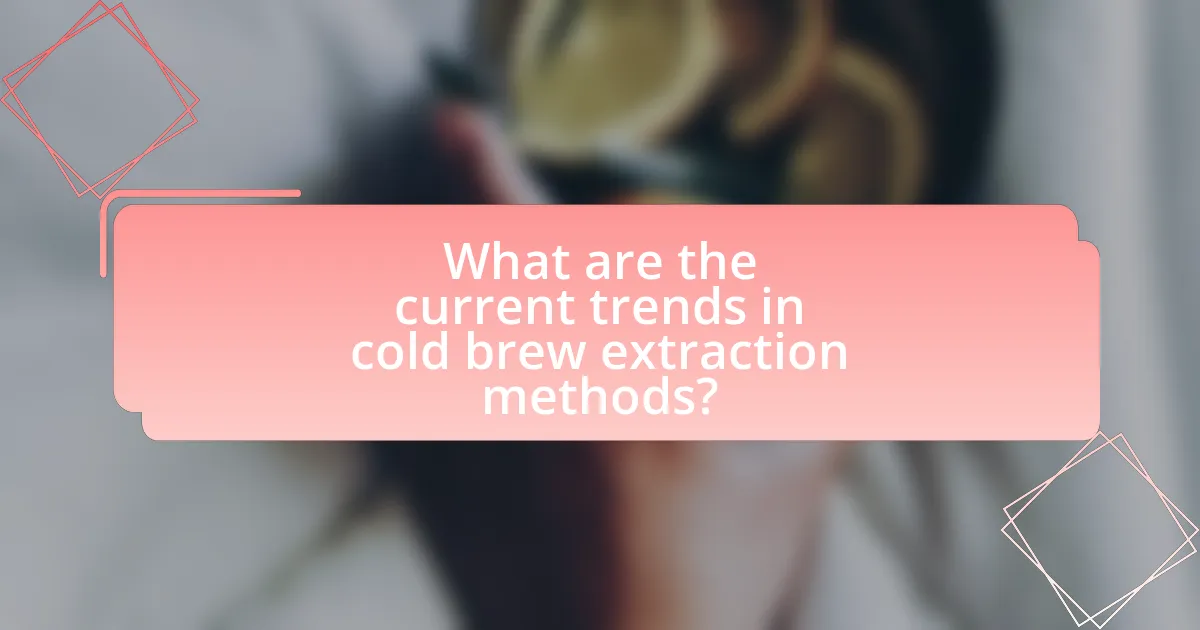The article focuses on the future of cold brew coffee, specifically examining innovations in extraction methods. It highlights current trends such as immersion brewing, nitro infusion, and advanced filtration techniques that cater to consumer demand for high-quality beverages. The discussion includes the impact of cold brew’s popularity on extraction techniques, the differences between traditional and modern methods, and emerging technologies like ultrasonic and pressure-assisted extraction. Additionally, it addresses the importance of consistency in flavor profiles, the influence of consumer preferences on future developments, and best practices for optimal cold brew extraction.

What are the current trends in cold brew extraction methods?
Current trends in cold brew extraction methods include the use of immersion brewing, nitro infusion, and advanced filtration techniques. Immersion brewing, which involves steeping coarsely ground coffee in cold water for an extended period, has gained popularity due to its simplicity and ability to produce a rich flavor profile. Nitro infusion, where nitrogen gas is added to cold brew, creates a creamy texture and enhances the drinking experience, making it a favored choice in cafes. Additionally, advanced filtration methods, such as using specialized cold brew systems that incorporate pressure or vacuum, are being adopted to improve extraction efficiency and flavor clarity. These trends reflect a growing consumer demand for high-quality, innovative cold brew options in the beverage market.
How has the popularity of cold brew influenced extraction techniques?
The popularity of cold brew has significantly influenced extraction techniques by promoting longer steeping times and coarser grind sizes. As consumers increasingly favor cold brew for its smooth flavor and lower acidity, coffee producers have adapted their methods to optimize these characteristics. For instance, cold brew typically involves steeping coffee grounds in cold water for 12 to 24 hours, which contrasts with traditional hot brewing methods that extract flavors more quickly. This shift has led to the development of specialized brewing equipment designed for cold extraction, such as immersion brewers and cold drip systems, which enhance flavor extraction while minimizing bitterness. Additionally, the emphasis on cold brew has encouraged research into the chemical compounds released during cold extraction, further refining techniques to achieve desired taste profiles.
What are the traditional methods of cold brew extraction?
Traditional methods of cold brew extraction primarily include immersion brewing and slow drip brewing. Immersion brewing involves steeping coarsely ground coffee in cold water for an extended period, typically 12 to 24 hours, allowing for a full extraction of flavors without heat. Slow drip brewing, on the other hand, utilizes a device that drips cold water over coffee grounds at a controlled rate, often taking several hours to complete the extraction process. Both methods emphasize a low-temperature environment to produce a smooth, less acidic coffee concentrate, which has been a staple in coffee preparation for decades.
How do modern extraction methods differ from traditional ones?
Modern extraction methods differ from traditional ones primarily in their use of advanced technology and efficiency. Traditional methods often rely on prolonged steeping or boiling, which can lead to over-extraction and undesirable flavors, while modern techniques, such as cold brew systems utilizing precise temperature control and pressure, optimize flavor extraction without bitterness. For instance, methods like vacuum extraction and ultrasonic extraction significantly reduce extraction time and enhance flavor profiles, as evidenced by studies showing that these techniques can yield a more balanced and aromatic beverage compared to conventional brewing methods.
What innovations are emerging in cold brew extraction technology?
Emerging innovations in cold brew extraction technology include the use of ultrasonic extraction, pressure-assisted extraction, and advanced filtration systems. Ultrasonic extraction utilizes high-frequency sound waves to enhance the extraction process, resulting in a more efficient and flavorful brew. Pressure-assisted extraction applies increased pressure to accelerate the infusion of coffee grounds, significantly reducing extraction time while maintaining flavor integrity. Advanced filtration systems, such as those using microfiltration or nanofiltration, improve the clarity and quality of the final product by effectively removing unwanted particulates and oils. These innovations are supported by research indicating that they can enhance flavor profiles and reduce brewing time, making cold brew more accessible and appealing to consumers.
How are advancements in equipment impacting cold brew production?
Advancements in equipment are significantly enhancing cold brew production by improving extraction efficiency and consistency. Modern cold brew systems utilize precise temperature control and optimized brewing times, which lead to a more uniform flavor profile and reduced bitterness. For instance, equipment like immersion brewers and cold brew towers allow for better extraction of soluble compounds from coffee grounds, resulting in a smoother and richer beverage. Additionally, innovations such as automated brewing machines and filtration systems streamline the production process, enabling higher volumes of cold brew to be produced with less labor and time. These advancements not only elevate the quality of the final product but also cater to the growing consumer demand for cold brew coffee, which has seen a 580% increase in sales from 2011 to 2019, according to the National Coffee Association.
What role does technology play in enhancing flavor profiles?
Technology plays a crucial role in enhancing flavor profiles by enabling precise control over extraction methods and ingredient interactions. Advanced techniques such as cold brew extraction, which utilizes lower temperatures and longer steeping times, allow for the development of smoother, less acidic flavors compared to traditional brewing methods. Additionally, innovations like ultrasonic extraction and pressure-assisted extraction can optimize the release of flavor compounds from coffee beans, resulting in a more complex and nuanced taste. Research indicates that these methods can significantly improve the extraction efficiency of desirable flavor compounds, thereby enhancing the overall sensory experience of cold brew beverages.

How do different extraction methods affect the taste of cold brew?
Different extraction methods significantly influence the taste of cold brew by altering the solubility of flavor compounds. For instance, immersion brewing typically results in a smoother, less acidic flavor profile due to the longer extraction time, which allows for the release of oils and sugars from the coffee grounds. In contrast, methods like flash brewing, which involve hot water for a brief period before cooling, can produce a more vibrant and complex flavor, highlighting acidity and fruity notes. Research indicates that the grind size and water temperature also play crucial roles; coarser grinds and lower temperatures generally yield a sweeter, less bitter brew, while finer grinds and higher temperatures can enhance bitterness and acidity. These variations in extraction methods directly correlate with the sensory attributes of the final cold brew, demonstrating that the choice of technique is essential for achieving desired taste profiles.
What are the flavor differences between various cold brew extraction techniques?
Cold brew extraction techniques yield distinct flavor profiles due to variations in brewing time, water temperature, and coffee grind size. For instance, immersion brewing, which involves steeping coarsely ground coffee in cold water for 12 to 24 hours, typically produces a smooth, rich flavor with low acidity. In contrast, the nitro cold brew method infuses cold brew coffee with nitrogen, resulting in a creamy texture and a slightly sweeter taste due to the enhanced mouthfeel. Additionally, the use of different coffee bean origins and roast levels can further influence flavor; lighter roasts may exhibit floral and fruity notes, while darker roasts can impart chocolatey and nutty flavors. Studies have shown that these variables significantly affect the sensory attributes of the final beverage, confirming the importance of extraction techniques in flavor development.
How does steeping time influence the taste of cold brew?
Steeping time significantly influences the taste of cold brew by affecting the extraction of flavors from the coffee grounds. Longer steeping times, typically ranging from 12 to 24 hours, result in a more robust and full-bodied flavor profile, as more soluble compounds, including oils and acids, are extracted. Conversely, shorter steeping times may yield a milder and less complex taste, as fewer flavor compounds are dissolved into the brew. Research indicates that optimal steeping time can enhance sweetness and reduce acidity, leading to a smoother beverage. For instance, a study published in the Journal of Food Science found that cold brew steeped for 18 hours had a higher concentration of desirable flavor compounds compared to those steeped for only 6 hours.
What impact does water temperature have on flavor extraction?
Water temperature significantly influences flavor extraction by affecting the solubility and diffusion rates of compounds in the beverage. Higher temperatures generally increase the extraction of flavors, as heat enhances the solubility of aromatic compounds and accelerates their release from the source material. For instance, studies show that brewing coffee at temperatures around 90-96°C can extract more oils and acids, resulting in a richer flavor profile compared to lower temperatures. Conversely, lower temperatures, such as those used in cold brew methods (around 4-10°C), extract fewer bitter compounds and acids, leading to a smoother, less acidic taste. This temperature-dependent extraction process is crucial for developing distinct flavor characteristics in beverages.
Why is consistency important in cold brew extraction?
Consistency is important in cold brew extraction because it ensures uniform flavor and quality in the final product. When the extraction process is consistent, the ratio of coffee to water, steeping time, and temperature remain stable, leading to a balanced and predictable taste profile. Research indicates that variations in these parameters can significantly affect the extraction of soluble compounds, which directly influences flavor, acidity, and overall quality. For instance, a study published in the Journal of Food Science found that maintaining consistent brewing conditions resulted in a more desirable sensory profile, highlighting the importance of precision in the extraction process.
How can variations in extraction methods lead to inconsistent results?
Variations in extraction methods can lead to inconsistent results due to differences in temperature, time, and solvent used during the process. For instance, higher temperatures can extract more soluble compounds, altering flavor profiles, while longer extraction times may result in over-extraction, introducing bitterness. Additionally, the choice of solvent, such as water versus alcohol, can significantly impact the chemical composition of the final product. Research indicates that these factors can cause variations in caffeine levels and flavor compounds, leading to a lack of uniformity in cold brew beverages.
What practices can ensure a consistent flavor profile in cold brew?
To ensure a consistent flavor profile in cold brew, it is essential to standardize the coffee-to-water ratio, maintain a consistent steeping time, and use uniform grind size. Standardizing the coffee-to-water ratio, typically around 1:4 to 1:8, allows for predictable extraction levels, which directly influence flavor. Maintaining a consistent steeping time, usually between 12 to 24 hours, ensures that the extraction process is uniform, preventing over-extraction or under-extraction. Additionally, using a uniform grind size, ideally coarser than regular coffee, promotes even extraction, which is crucial for achieving a balanced flavor profile. These practices are supported by industry standards that emphasize the importance of consistency in brewing methods to achieve desired taste outcomes.

What are the future prospects for cold brew extraction methods?
The future prospects for cold brew extraction methods include advancements in technology that enhance flavor extraction and efficiency. Innovations such as ultrasonic extraction and pressure-assisted methods are being explored to reduce brewing time while maintaining or improving flavor profiles. Research indicates that these methods can yield a more consistent and robust taste, appealing to a growing consumer base that values quality and convenience. Additionally, the increasing popularity of cold brew coffee in various markets suggests a sustained demand for improved extraction techniques, driving further investment and development in this area.
How might consumer preferences shape the future of cold brew extraction?
Consumer preferences will significantly shape the future of cold brew extraction by driving demand for diverse flavor profiles and sustainable practices. As consumers increasingly seek unique taste experiences, companies may innovate extraction methods to enhance flavor complexity, such as experimenting with different coffee bean origins and varying steeping times. Additionally, the growing emphasis on sustainability will likely push brands to adopt eco-friendly practices, such as using biodegradable packaging and sourcing ethically produced coffee. According to a 2022 survey by the Specialty Coffee Association, 70% of consumers prioritize sustainability in their purchasing decisions, indicating that these preferences will influence how cold brew products are developed and marketed.
What trends are emerging in consumer demand for cold brew products?
Emerging trends in consumer demand for cold brew products include a growing preference for ready-to-drink options, increased interest in diverse flavor profiles, and a shift towards organic and sustainably sourced ingredients. The ready-to-drink segment is expanding rapidly, with sales projected to reach $1.5 billion by 2025, driven by convenience and on-the-go consumption. Additionally, consumers are seeking unique flavors, such as seasonal and exotic infusions, which cater to adventurous palates. The demand for organic and sustainably sourced cold brew reflects a broader trend towards health-conscious and environmentally friendly choices, with 60% of consumers indicating a willingness to pay more for such products.
How can sustainability influence future extraction methods?
Sustainability can significantly influence future extraction methods by promoting the development of eco-friendly techniques that minimize environmental impact. For instance, the adoption of methods such as cold extraction and supercritical CO2 extraction reduces energy consumption and waste generation compared to traditional methods. Research indicates that cold extraction preserves flavor compounds while using less water and energy, aligning with sustainable practices. Additionally, the integration of renewable energy sources in extraction processes can further enhance sustainability, as evidenced by studies showing that solar-powered extraction systems can reduce carbon footprints by up to 50%.
What challenges do innovators face in developing new extraction methods?
Innovators face several challenges in developing new extraction methods, primarily including technical limitations, cost constraints, and regulatory hurdles. Technical limitations arise from the need to optimize extraction efficiency while maintaining flavor integrity, which often requires advanced equipment and methodologies. Cost constraints can hinder the adoption of innovative techniques, as high initial investments may not guarantee a return on investment. Regulatory hurdles also pose significant challenges, as compliance with food safety standards and environmental regulations can complicate the development and implementation of new methods. For instance, the Food and Drug Administration (FDA) has strict guidelines that must be adhered to, impacting the feasibility of certain extraction processes.
What are the technical limitations of current cold brew extraction technologies?
Current cold brew extraction technologies face several technical limitations, primarily related to extraction efficiency, temperature control, and time consumption. Extraction efficiency is often hindered by the solubility of coffee compounds at lower temperatures, which can result in under-extraction of flavors and aromas. Additionally, maintaining precise temperature control during the brewing process is challenging, as fluctuations can affect the consistency and quality of the final product. Time consumption is another limitation, as traditional cold brew methods typically require extended steeping periods, often ranging from 12 to 24 hours, which can be impractical for commercial production. These limitations highlight the need for advancements in extraction technologies to enhance flavor profiles and streamline production processes.
How can industry collaboration drive innovation in cold brew extraction?
Industry collaboration can drive innovation in cold brew extraction by facilitating the sharing of knowledge, technology, and resources among companies. Collaborative efforts, such as joint research initiatives and partnerships between coffee producers, equipment manufacturers, and academic institutions, can lead to the development of new extraction techniques that enhance flavor profiles and efficiency. For instance, a partnership between a coffee roaster and a technology firm could result in the creation of advanced brewing equipment that optimizes extraction time and temperature, thereby improving the final product. Additionally, industry collaboration can enable the pooling of financial resources for research and development, allowing for more ambitious projects that might be too costly for a single entity. This collaborative approach has been shown to accelerate innovation cycles, as evidenced by the rapid advancements in brewing technology seen in recent years.
What best practices should be followed for optimal cold brew extraction?
For optimal cold brew extraction, use a coffee-to-water ratio of 1:4 to 1:8, depending on desired strength. This ratio ensures a balanced flavor profile, as studies indicate that higher coffee concentrations yield richer flavors. Additionally, coarsely grind the coffee beans to increase surface area while minimizing over-extraction, which can lead to bitterness. Steeping the mixture for 12 to 24 hours at room temperature or in the refrigerator allows for a smooth extraction process, as longer steeping times enhance flavor without introducing unwanted acidity. Finally, filter the brew using a fine mesh or paper filter to achieve clarity and remove sediment, ensuring a clean final product.
How can home brewers achieve the best results with cold brew extraction?
Home brewers can achieve the best results with cold brew extraction by using a coffee-to-water ratio of 1:4 to 1:8, depending on desired strength. This ratio ensures optimal flavor extraction while minimizing bitterness. Additionally, coarsely grinding the coffee beans enhances extraction efficiency, as finer grinds can lead to over-extraction and undesirable flavors. Brewing time should be between 12 to 24 hours, with longer steeping times yielding richer flavors. Finally, using filtered water improves the overall taste by removing impurities that can affect flavor. These methods are supported by studies indicating that proper ratios, grind size, and steeping times significantly influence the quality of cold brew coffee.
What tips can professionals use to refine their cold brew techniques?
Professionals can refine their cold brew techniques by experimenting with different coffee-to-water ratios, typically ranging from 1:4 to 1:8, to achieve desired strength and flavor. Adjusting the grind size is also crucial; a coarser grind generally yields a smoother taste, while a finer grind can enhance extraction but may lead to bitterness. Additionally, steeping time should be optimized, with a range of 12 to 24 hours being common, as longer steeping can intensify flavors but may also extract undesirable compounds. Temperature control during brewing is important; using cold or room temperature water can result in a cleaner profile compared to hot water. Finally, utilizing high-quality, freshly roasted beans ensures better flavor extraction, as older beans may lack the necessary oils and compounds for optimal cold brew.


